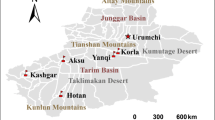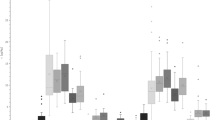Abstract
Approximately 15,000 tons of wild boar meats (Sus scrofa) are consumed per year in Germany. Boar meat therefore plays a definite role in regard to human diet. Because they are omnivores and because of their high body fat quotient, wild boar may accumulate large concentrations of persistent organic compounds, such as halogenated hydrocarbons, and could thus possibly serve as bioindicators for persistent xenobiotics. In addition, consumption of wild boar meat and liver could lead to increased contaminant levels in humans. Between 2007 and 2009, we tested a total of 529 livers and 506 muscle tissue samples from wild boar for the presence of perfluorooctanoic acid (PFOA) and perfluorooctane sulfonate (PFOS). PFOA concentrations ≤45 μg/kg and PFOS concentrations ≤1,780 μg/kg were detected in the liver samples. PFOA concentrations ≤7.4 μg/kg and PFOS concentrations ≤28.6 μg/kg were detected in muscle tissue. Our results show that PFOS may be detected in considerably greater concentrations than PFOA in organs and tissues, which is in agreement with results from other published studies. The comparisons between both organs for the same substance, as well as the comparisons between the substances within an organ, showed clear and statistically significant differences at P < 0.0001. Assuming a tolerable daily intake value of PFOA (1.5 μg/kg bw/d) and PFOS (0.15 μg/kg bw/d) as recommended by the European Food Safety Authority, the results of model calculations based on the maximum concentrations of PFOA and PFOS found in wild boar indicate that there should be no PFC-related health danger resulting from moderate consumption of wild boar meat or liver.

Similar content being viewed by others
References
Anastassiades M, Lehotay SJ, Stajnbaher D, Schenck FJ (2003) Fast and easy multiresidue method employing acetonitile extraction/partitioning and “dispersive solid-phase extraction” for the determination of pesticide residues in produce. J AOAC Int 86(2):412–431
Bladt State Office for Agriculture, Food Safety and Fishery (2008) Studies of perfluorinated surfactants by the State Office for Agriculture, Food Safety and Fishery, Mecklenburg West Pomerania PFT-Colloquium—Technical discussions on risk assessment of animal feed, ministry of the environment and conservation, agriculture and consumer protection. North Rhine-Westphalia and the Federal Institute for Risk Assessment, Düsseldorf, Germany
Bottermann H, The Office of the President, State Office of Conservation, Environmental, and Consumer Protection North Rhine-Westphalia (2008) Perfluorinated surfactants: Findings of the Surveillance Authority in North Rhine–Westphalia, Colloquium—Technical discussions on risk assessment of animal feed, ministry of the environment and conservation, agriculture and consumer protection. North Rhine–Westphalia and the Federal Institute for Risk Assessment, Düsseldorf, Germany
Cytel Studio StatXact Version 9.0.0 (2010) Statistical software for exact nonparametric inference: User manual. CYTEL, Cambridge
Dai J, Li M, Jin Y, Saito N, Xu M, Wei F (2006) Perfluorooctanesulfonate and perfluorooctanoate in red panda and giant panda from China. Environ Sci Technol 40:5647–5652
D’Hollander W, de Voogt P, De Coen W, Bervoets L (2010) Perfluorinated substances in human food and other sources of human exposure. Rev Environ Contam Toxicol 208:179–215
Dixon JW (1993) Bmdp User’s Digest: Quick Reference for the Bmdp Programs to Accompany Bmcp Release 7: BMDP Release 7, University of California Press, USA
European Food Safety Authority (2008) Perfluorooctane sulfonate (PFOS), perfluorooctanoic acid (PFOA) and their salts—scientific opinion of the panel on contaminants in the food chain. EFSA J 653:1–131
Fair PA, Adams J, Mitchum G, Hulsey TC, Reif JS, Houde M et al (2010) Contaminant blubber burdens in Atlantic bottlenose dolphins (Tursiops truncatus) from two southeastern US estuarine areas: concentrations and patterns of PCBs, pesticides, PBDEs, PFCs, and PAHs. Sci Total Environ 408(7):1577–1597
Falandysz J, Taniyasu S, Yamashita N, Rostkowski P, Zalewski K, Kannan K (2007) Perfluorinated compounds in some terrestrial and aquatic wildlife species from Poland. J Environ Sci Health A 42:715–719
Falk S (2008) Vorkommen perfluorierter Tenside am Beispiel der Leitsubstanzen PFOS and PFOA. Masters thesis. Faculty 09-Agricultural Sciences, Nutritional Sciences and Environmental Management, Justus-Liebig-Universität of Giessen, Germany
Falk S, Brunn H, Schröter-Kermani C, Failing K, Georgii S, Tarricone K, Stahl T (2012) Temporal and spatial trends of Perfluorinated Compounds (PFC) in liver of roe deer (Capreolus capreolus L.). In preparation
Giesy J, Kannan K (2001) Global distribution of perflurooctane sulfonate in wildlife. Environ Sci Technol 35:1339–1342
Hänsel A, Department 23, Residue Testing Service, Lower Saxony State Office for Consumer Protection and Food Safety (2008) Perfluorinated surfactants: results of studies in Lower Saxony 2007. Perfluorinated surfactants: Colloquium—Technical discussions on risk assessment of animal feed, ministry of the environment and conservation, agriculture and consumer protection. North Rhine-Westphalia and the Federal Institute for Risk Assessment, Düsseldorf, Germany
Hart K, Kannan K, Tao L, Takahashi S, Tanabe S (2008) Skipjack tuna as a bioindicator of contamination by perfluorinated compounds in the oceans. Sci Total Environ 403(1–3):215–221
Haug LS, Thomsen C, Becher G (2009) Time trends and the influence of age and gender on serum concentrations of perfluorinated compounds in archived human samples. Environ Sci Technol 43(6):2131–2136
Hoelzer J, Göen T, Rauchfuss K, Kraft M, Angerer J, Kleeschulte P, Wilhelm M (2009) One-year follow-up of perfluorinated compounds in plasma of German residents from Arnsberg formerly exposed to PFOA-contaminated drinking water. Int J Hyg Environ Health 212(5):499–504
Kannan K, Newsted J, Halbrook RS, Giesy JP (2002) Perfluorooctanesulfonate and related fluorinated hydrocarbons in mink and river otters from the United States. Environ Sci Technol 36:2566–2571
Kannan K, Yun SH, Evans TJ (2005) Chlorinated, brominated, and perfluorinated contaminants in livers of polar bears from Alaska. Environ Sci Technol 39:9057–9063
Kärrman A, Domingo JL, Llebaria X, Nadal M, Bigas E, van Bavel B, Lindström G (2010) Biomonitoring perfluorinated compounds in Catalonia, Spain: concentrations and trends in human liver and milk samples. Sci Pollut Res Int 17(3):750–758
Kim WK, Lee SK, Jung J (2010) Integrated assessment of biomarker responses in common carp (Cyprinus carpio) exposed to perfluorinated organic compounds. J Hazard Mater 180(1–3):395–400
Kombal R: Perfluorinated Surfactants in Wild Boar Liver (2009) Survey in Lower Saxony within the framework of the statewide surveillance plan (BÜp) in 2007 and 2008. Poster. German Food Chemistry Meeting, September 14–16, Berlin, Germany
Li X, Yeung LW, Taniyasu S, Lam PK, Yamashita N, Xu M, Dai J (2008) Accumulation of perfluorinated compounds in captive Bengal tigers (Panthera tigris tigris) and African lions (Panthera leo Linnaeus) in China. Chemosphere 73(10):1649–1653
Lower Saxony State Office for Consumer Protection and Food Safety (2009). http://www.laves.Niedersachsen.de/master/C42107703_N7351364_L20_D0_I826.html. Accessed January 11, 2011
Meyer J, Jaspers VL, Eens M, de Coen W (2009) The relationship between perfluorinated chemical levels in the feathers and livers of birds from different trophic levels. Sci Total Environ 407(22):5894–5900
Niedersächsisches Landesamt für Verbraucherschutz und Lebensmittelsicherheit (2009) Available at: http://www.laves.Niedersachsen.de/master/C42107703_N7351364_L20_D0_I826.html. Accessed: January 11, 2011
O’Connell SG, Arendt M, Segars A, Kimmel T, Braun-McNeill J, Avens L et al (2010) Temporal and spatial trends of perfluorinated compounds in juvenile loggerhead sea turtles (Caretta caretta) along the East Coast of the United States. Environ Sci Technol 44(13):5202–5209
Olivero-Verbel J, Tao L, Johnson-Restrepo B, Guette-Fernandez J, Baldiris Avila R et al (2006) Perfluorooctanesulfonate and related fluorochemicals in biological samples from the north coast of Colombia. Envrion Pollution 142:367–372
Perkins RG, Butenhoff JL, Kennedy GL, Palazzolo MJ (2004) 13-Week dietary toxicity study of ammonium perfluorooctanoate (APFO) in male rats. Drug Chem Toxicol 27:361–378
Schuetze A, Heberer T, Effkemann S, Juergensen S (2010) Occurrence and assessment of perfluorinated chemicals in wild fish from northern Germany. Chemosphere 78(6):647–652
Seacat AM, Thomford PJ, Hansen KJ, Olsen GW, Case MT, Butenhoff JL (2002) Subchronic toxicity studies on perfluorooctanesulfonate potassium salt in cynomolgus monkeys. Toxicol Sci 68(1):249–264
Sreedevi V, Kumar PR, Thatavarti R (2011) LC-MS method development and validation for the estimation of felodipine in human plasma and stability studies of freeze thaw analyte. Int J Pharm Biomed Res 2(2):65–73
Van Leeuwen SP, van Velzen MJ, Swart CP, van der Veen I, Traag WA, de Boer J (2009) Halogenated contaminants in farmed salmon, trout, tilapia, pangasius, and shrimp. Environ Sci Technol 43(11):4009–4015
Watanabe MX, Kunisue T, Tao L, Kannan K, Subramanian A, Tanabe S et al (2010) Dioxin-like and perfluorinated compounds in pigs in an Indian open waste dumping site: toxicokinetics and effects on hepatic cytochrome P450 and blood plasma hormones. Environ Toxicol Chem 29(7):1551–1560
Wilhelm M, Hölzer J, Dobler L, Rauchfuss K, Midasch O, Kraft M, Angerer J, Wiesmüller G (2009) Preliminary observations on perfluorinated compounds in plasma samples (1977–2004) of young German adults from an area with perfluorooctanoate-contaminated drinking water. Int J Hyg Environ Health 212(2):142–145
Yeung LW, Yamashita N, Taniyasu S, Lam PK, Sinha RK, Borole DV, Kannan K (2009) A survey of perfluorinated compounds in surface water and biota including dolphins from the Ganges River and in other waterbodies in India. Chemosphere 76(1):55–62
Zhang T, Wu Q, Sun HW, Zhang XZ, Yun SH, Kannan K (2010) Perfluorinated compounds in whole blood samples from infants, children, and adults in China. Environ Sci Technol 44(11):4341–4434
Acknowledgments
We express gratitude to the Hessian Ministry for the Environment, Energy, Countryside, and Consumer Protection for financial support. Special thanks to our technical staff, Rosa Maria Sobel, Marlies Ebel, Maria Arabatzoudi, and Vanessa Gellrich, for their efforts in sample preparation and analysis. We also thank Roy Ackmann and Barbara Gamb for their assistance in the extensive literature search.
Author information
Authors and Affiliations
Corresponding author
Rights and permissions
About this article
Cite this article
Stahl, T., Falk, S., Failing, K. et al. Perfluorooctanoic Acid and Perfluorooctane Sulfonate in Liver and Muscle Tissue from Wild Boar in Hesse, Germany. Arch Environ Contam Toxicol 62, 696–703 (2012). https://doi.org/10.1007/s00244-011-9726-3
Received:
Accepted:
Published:
Issue Date:
DOI: https://doi.org/10.1007/s00244-011-9726-3




